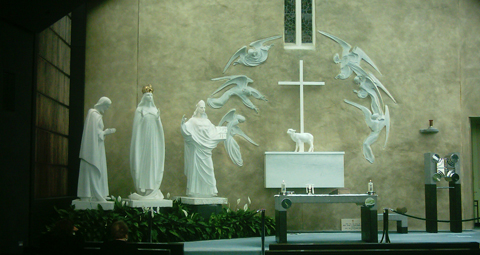BY Amanda Connelly | September 29 | ![]() 0 COMMENTS
0 COMMENTS ![]() print
print

Devotions to Our Lady span the world
AMANDA CONNELLY looks at some the spectacular shrines to Our Blessed Mother, from Mexico to Ireland
Motherhood has always held a particularly notable place in society. In the past, women were strongly encouraged to have children and become mothers—a job that was prioritised over earning a wage (however problematic this was).
Without mothers, the human race would also simply cease to exist. On a lighter note perhaps, few of us could disagree that when you’re not at your best, a hug off your mammy is a cure-all solution.
Our Blessed Mother is no exception to this. She has been revered by Christians (and Muslims) for thousands of years—long before the days of schmaltzy cards, pink bouquets and ‘World’s Best Mummy’ mugs lined the supermarket shelves.
While in the modern world, the urgent demand we once saw for women to bear children has decreased, devotions to Mary Our Mother are still going strong.
Being from Carfin, I have the national Marian shrine on my own doorstep—Carfin Lourdes Grotto. I visited it often throughout my childhood, and seeing Our Lady placed on such a pedestal (both literally and metaphorically) undoubtedly instilled in me the idea of how important she was to Catholics as our Mother.
Travelling to Lourdes both this year and last only compounded this view—how could you not see how special Our Lady is, when so many people flock with such attentiveness and devotion to one of the most famous Marian shrines in the world, where Mary appeared to Bernadette 160 years ago next year?
Yet while Carfin is a popular shrine for many Scottish pilgrims, thousands flock to Lourdes throughout the year, and the recent 100th anniversary celebrations of Our Lady’s apparitions at Fatima saw the spotlight shone on the popular Portuguese shrine.
But there remain many other shrines to Our Lady across the world, each with their own fascinatingly beautiful, touching and intriguing stories to offer.
Jetting across the Atlantic Ocean, you will find yourself in one of the world’s most traditionally Catholic countries: Mexico. Its capital, Mexico City—or Ciudad de Mexico to its locals—is the heart of a country in which 83 per cent of its people describe themselves as belonging to the Faith.
There in the city is the stunning Basilica of Our Lady of Guadalupe, the most visited Catholic shrine in the world.
It was here that in December 1531 Our Lady appeared to the Aztec convert Juan Diego, who asked him to build a church at the site. When he spoke to the Spanish bishop, Juan Diego’s claims were dismissed, and he was told to present a miraculous sign to prove his story.
The Virgin Mary once again appeared to Juan Diego and asked him to gather flowers, while Spanish roses bloomed at his feet despite it being the dead of winter.
When Juan Diego let the roses fall from his apron in front of the bishop, an icon of the Virgin Mary was imprinted on to the cloth.
The bishop ordered a church to be erected immediately, and it has been a popular shrine ever since.
Our Lady of Guadalupe is a source of great pride for Mexicans today, as patroness of the city and with Juan Diego becoming the first Mexican saint. The apron can still be viewed today at the basilica, beautifully intact.
Trekking across to the other side of the world is another hub of Catholicism: the Philippines. The Pacific island has become a popular destination for gap year students and backpackers in recent times, who favour ‘authenticity’ amidst the tranquillity of south-east Asia over the typical sun, sea and sand package deal out of the local travel agents.
Yet Our Lady had long recognised the beauty of the country before the rush of the backpackers seeking the perfect backdrop for their latest Instagram post. She chose Manaoag, which aptly means ‘to call,’ to call upon a local farmer to build her church.
The middle-aged man reportedly heard the voice of a mysterious woman calling him in 1610. Our Lady appeared upon a cloud-veiled treetop, bearing the Rosary in her right hand and the Child Jesus in her left, surrounded by a Heavenly glow.
A basilica was built in her honour, where stands a 17th century ivory statue of the Virgin Mary with the Child Jesus at the altar, venerated today as part of Filipino custom.
A number of extraordinary miracles have been attributed to Our Lady of Manaoag, including the inability of pillagers to destroy the church as they shot flaming arrows towards it during the Spanish era. Similarly, during the Second World War, Japanese forces dropped four bombs on the church. Three landed on the plaza and facade, destroying them both. Yet the fourth landed in the sanctuary, and did not explode. A truly miraculous event.
The image was granted a Canonical Coronation in 1926, while Pope Emeritus Benedict XVI raised the sanctuary in equal indulgences to the Basilica of St Mary Major in 2011.
Back in Europe, Belgium marks another location of more than one Marian apparition. Admittedly, I had no idea the country had been the site of a Marian apparition, let alone two. On both occasions I have been in Belgium, I sheepishly confess that neither contained a visit to either of the shrines—just chocolate shops. However, next time I’ll pay a visit.
One such apparition was in the hamlet of Banneux, 15 kilometres south of Liège in 1933. Teenager Mariette Beco saw the Virgin Mary in the garden from her kitchen window, asking her to come outside. Her mother refused. The lady came again to Mariette three days later, calling herself Our Lady of the Poor. She appeared a total of eight times, on one occasion telling the young Mariette to place her hands into a small spring that was for healing and ‘for all nations.’
The spring currently gives out around 2,000 gallons of water a day, with many reported cures.
A small chapel stands today where the Virgin of the Poor reportedly asked for one to be built. Mariette was taunted for what she saw even by members of her own family, while local boys called her Bernadette, until the Holy See declared the apparitions definite in 1949—16 years after they first took place.
She married and had children, maintaining a private life thereafter, saying a few years before her death in 2011, at aged 90, that she was ‘no more than a postman who delivers the mail.’ She said: “Once this has been done, the postman is of no importance anymore.”
Perhaps it’s sadly unsurprising that poor Mariette was teased for her reports of what she had seen—I know I had my fair share of ribbing for going to Mass as a teen, so I can only imagine the stick Mariette got for saying the Virgin Mary had turned up literally on her back doorstep.
And yet she’s the perfect example of our dedication to loving and defending our mothers, including Our Lady. Her dedication to relaying Mary’s message and refusal to turn her back on what the Virgin revealed to her is a true testament to her character, and perhaps something from which we can all learn when it comes to honouring both our earthly and heavenly mother.
As well as the support we should give to mothers, the apparitions of Our Blessed Lady can also demonstrate her undying mother’s love for us.
Closer to home across the water lies County Mayo in Ireland, home to the village of Knock. In 1879, Ireland was undoubtedly the site of much political, social and cultural upheaval, and its historical issues were not so distant.
Yet as a group of 15 people gathered at 8pm at the south gable of a small local church, the vision of the Virgin Mary, St Joseph, St John the Evangelist, the lamb on the altar and a throng of heavenly angels appeared. It was proof of the steadfast support mothers, especially Our Blessed Mother, can give us in times of hardship. As countless Marian shrines around the world highlight, our need and love for Mary Our Mother continues to prevail.
A visit perhaps to one of the lesser-known shrines dedicated to Our Lady is perhaps one way we can remind ourselves why love and support for earthly mothers, and of course Our Lady in Heaven, is so important.
We can allow ourselves to be inspired by this extraordinary commitment we see through shrines that exist across the globe, even today.










